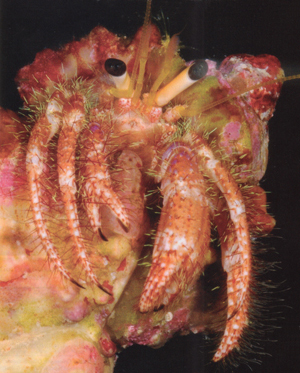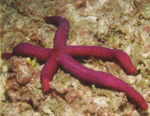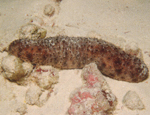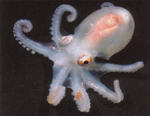Around the globe,scientists are ringing alarm bells about coral bleaching—when corals expel their symbiotic, food-producing algae due to heat stress, they can starve and die—one of the most alarming aspects of this to marine invertebrate researcher Gustav Paulay is that our heating planet may be killing off many species before science can discover them and understand their ecological roles.
University of Florida zoology graduate student Seabird McKeon worked with Gustav Paulay on the CReefs expedition to the French Frigate Shoals.
“I used to fear that I had missed out on the golden age of biological diversity, that the true exploration was left only for astronauts,” McKeon said. “Expeditions like this one prove that nothing could be further from the truth. The ocean is another world, no farther away than the beach, and we are only just beginning to explore it.”
McKeon studies how interspecies relationships create and maintain biodiversity over ecological and evolutionary time. He participated in the expedition to explore hypotheses on how ecology influences patterns of biodiversity and biogeography found in marine organisms. He kept a personal journal throughout the expedition. On Oct. 26, 2006, when the research vessel Oscar Elton Sette was running back to port, he wrote: We leave having barely touched the mystery and wonder that surrounds this place. Biological diversity is a uniquely humbling and compelling subject—symbiosis, biogeographic patterns, evolutionary pathways—our observations have led to more questions than answers. In this most remote outpost of tropical marine diversity, our science is in its infancy, a wide-eyed exploration of the unknown. For the first time, I realize that we are just getting started.
Gustav Paulay, a curator of invertebrate zoology at the Florida Museum of Natural History, is participating in several large-scale marine biodiversity surveys to find and document as many existing invertebrate species as possible, before they disappear forever.
“It is likely that reef ecosystems are going to collapse in the next 50 years because of global warming,” Paulay said. “So what we are trying to do is capture a record of what lives on reefs now while these ecosystems are still relatively intact. Fifty years from now, natural resources managers will be relying on these observations as they try to restore or manage what remains of coral reefs.”
Two of the larger and more recent reef survey projects Paulay has participated in are the Census of Coral Reefs (CReefs) and Moorea Biocode. Paulay says they routinely turn up new species, which underscores how poorly understood our oceans are.
“Reef biodiversity remains greatly underdescribed,” Paulay said. “In fact we don’t even know roughly how many species live on reefs, but surveys by our lab suggest that likely over a million animal species inhabit coral reefs.”
Last October, Paulay co-led the three week kick-off CReefs expedition to the French Frigate Shoals off northwestern Hawaii with an all-star team of taxonomists and scientists aboard. It was the first of several CReefs expeditions planned under the international Census for Marine Life, a 10-year initiative to assess the diversity, distribution and abundance of marine life with an interpretive eye toward how these factors change through time.
In Hawaii, Paulay and other researchers found about 50 invertebrate tropical reef species previously unknown to science. New species were discovered from an atoll in an area that President Bush demarcated last year as the Northwestern Hawaiian Islands Marine National Monument.
“There is lots of groundwork to verify these are new species,” Paulay said. “But what is interesting is that these are from a relatively well-studied and low diversity area of the Pacific, yet some of them are fairly large and conspicuous. It highlights how little we know of reef biodiversity.”
Three different types of sea cucumbers, a one-foot-long vivid-purple sea star, several hermit crabs, octopi, clams, sea squirts, barnacles, segmented worms, anemones and brittle stars were among the new species finds. Also discovered was a type of coral so unique that researchers are unsure of its genus. Sampling methods were meticulously designed to minimize environmental degradation. Researchers used low suction underwater vacuuming, plankton tows, brushing of rubble, light traps, baited traps, hand collecting and sediment and water sampling.

Photo by Gustav Paulay
Paulay participated in a similar reef survey near Moorea Island in French Polynesia in June-July 2006, which he said generated more specimens than the French Frigate Shoals expedition. Specimens from this survey feed the Barcode of Life Database, a separate project with the goal of sequencing selected gene regions of every living critter and plant on earth. Minute tissue samples are taken from the reef specimens and provided to the Barcode of Life Database, which produces identifying DNA tags, also called DNA barcodes, for each species. These barcodes can be used to facilitate species identification and will be used in the future to power a yet-to-be-developed hand-held DNA barcode reader.
“That’s probably five to 10 years down the road, but we’ll have it eventually.” He pointed out that of the planet’s estimated 10 million species, only about one or two million are currently described by science.
In the meantime, he’ll be racing out again this August to the islands of Mauritius, Reunion and Seychelles in the southwest Indian Ocean on a hunt to gather more data on the globe’s imperiled coral reef systems.
“I just really want to know what is out there, on these reefs,” Paulay said. “That’s what excites me. All these initiatives are just different ways of getting this done, and new tools by which we can do things better.”




